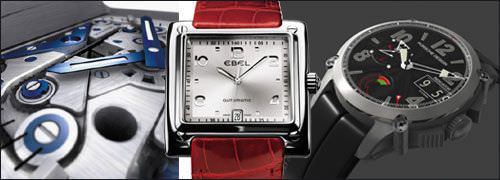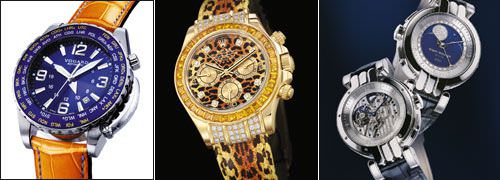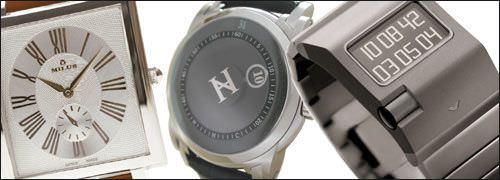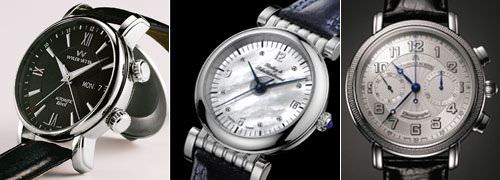During the two-week period of the BaselWorld and SIHH shows, those first feelings of relief would transform themselves into a gentle euphoria, nourished by the bottles of champagne whose corks were already popping in the morning.
The buyers (agents, wholesalers, retailers) were finally back. Their numbers were up 38.8% in relation to 2003, at around 89,350 for BaselWorld, and up 20% at SIHH to 10,000, which represented about the same visitor counts as the 2002 shows. And, these buyers did not come just to visit; they came to fill their order books. In all sectors, brands were, for the most part, smiling again. After a year of profound depression, watchmaking was beginning to show signs of recovery.
Yet, soon another sentiment started to make itself felt. Was it simply caution being expressed in reaction to the scepticism of the past twelve monthsı Perhaps, but we began hearing, “Let’s wait for the confirmations.” This phrase turned into a generalized “off the record” comment by the ostensibly jubilant watchmakers. The question could then be asked: Was this simply the effect of the euphoric reaction to seeing buyers againı On the other hand, what would the ‘buyers’ finally decide, after having returned to their offices, far from the festive atmosphere of the fairsı Would they confirm their ordersı
“Prudence is one of the components of strength.”
On the last day of the SIHH, one of the Richemont group CEOs shared his concerns with me. “All this euphoria scares me a little,” he confided. “It seems a little too artificial, and no one knows where this is all leading to. We are dancing on the edge of the volcano, yet, in order to forget that fact, we keep bidding higher...”
This concern found its echo in the official ‘Closing Report’ of the SIHH. In the words of the eminence grise, Franco Cologni, President of the Surveillance Board of the SIHH, we noted a similar point of view. “In spite of this surprising recovery, prudence remains a capital virtue. Along with patience, which we had last year, it is one of the components of strength.”
The management of BaselWorld did not display the same lucid concern, affirming unabashedly that the current fair was “the best ever Show!” in the opinion of many exhibitors. It is true that BaselWorld has come a long way since the opening day of April 3, 2003 when the American troops announced the capture of Saddam International Airport and the fair management announced the ‘pull-out’ of the brands from Hong Kong and other Asian nations.
With the aborted attempt of delocalization to Zurich behind them, the watchmakers from Hong Kong were cheerful again as they settled into the new Hall 6, which will be their home for at least the next six years. According to Lore Buscher, Director of the HKTDC for Europe, “BaselWorld represents once again the most important fair in the world for us.” (See our article on this topic in this issue.)
Confirming the general optimistic attitude were the results of Swiss exports for the month of March, published, moreover, during BaselWorld. They showed exports of Swiss watch products up by 15.9% compared to the same month last year, with a record turnover of 896.4 million Swiss francs and an increase of 21% in the number of pieces. Even so, a few discordant voices could be heard above the euphoric chorus. “Off the record,” said manufacturers of component parts, declines of up to 50% were registered. This raises doubts about the absolute veracity of the Swiss customs’ numbers. And, certain voices even claimed that a number of firms, including some of the industry’s largest, were exporting their pieces, only to re-import them later, thus inflating their own statistics...

Monaco V4 Concept Watch by TAG Heuer
1911 La Carrée by Ebel
The ‘Indicator’ of Porsche Design
A ‘talking piece’
Whether these fears and claims are founded or not, one thing was quite noticeable this year – creativity was not lacking. We had doubts earlier about it, but in fact, this year’s crop of new timekeepers was quite surprising. The ‘talking piece’ at Basel was TAG Heuer’s ‘revolutionary’ prototype, the Monaco V4 Concept Watch. Conceived and designed by Jean-François Ruchonnet and produced in the ateliers of TAG Heuer, it was assembled and finished by one of Switzerland’s master watchmakers, Philippe Dufour. His involvement was seen as absolutely necessary in order to satisfy all those sceptics who predicted that this new timekeeper would never work. It is also a paradox that it was one of the industry’s most traditional watchmakers who contributed to the development of this radically new approach to mechanical timekeeping. Inspired by the automobile, the Monaco V4, which gets its name from the four cylinders mounted in a V on the engine, the Monaco V4 Concept Watch includes some really spectacular innovations. The traditional pinions are replaced by 13 toothed micro-belts, fashioned from a “strategic” and “top secret” material. The traditional rotor has been replaced by a linear oscillating weight mounted on ceramic micro ball-races. Through its gearing, it drives a toothed wheel that converts the linear movement into rotational movement. The jewels have been replaced by ceramic micro ball-races.
The considerable energy furnished by the four barrels (a total of 1.5 kilo) opens new horizons for the world of mechanical watchmaking. How and in which directionsı As Philippe Dufour himself declared, “It is still too early to tell” and it will most probably take two to three years before the prototype can be taken to the industrialization stage.
Whatever happens, this demonstration of pure creativity is a huge credit to TAG Heuer, which showed a great deal of courage in accepting the ‘crazy’ idea of Ruchonnet, a man who is already looking at new revolutionary concepts, inspired this time by boats and planes. (For more on this watch, see our Cover Story.)
The brand is clearly in good form since it also presented another innovation in terms of both technique and marketing. For the first time, a chronograph has pushbuttons, not on the side of the case, but on the top of the bezel. To be among the lucky ones to actually have the “right” to purchase this SLR Chronograph by TAG Heuer, you must first spend about 350,000 euros to acquire the Mercedes-Benz SLR McLaren. You certainly can’t get more exclusive than that!
The spectacular fireworks emanating from this device, heavily promoted by Jean-Christophe Babin, TAG’s CEO, in his usual passionate manner, were not enough, however, to squash the growing rumours that “LVMH wants to sell TAG Heuer…but it is very expensive” or that “LVMH is going to sell Zenith!”
Ebel’s new re-beginning
At Ebel, which was recently sold by LVMH to the American group Movado, no one was talking about those rumours. Rather, the brand was elated to be back in the hands of ‘real’ watchmakers. It is much too early to say exactly how Movado intends to get its newly acquired brand back on its feet, but several indications are already being seen. Essentially, Ebel is going to head straight back on the road to its timekeeping ‘fundamentals’ after years of aimless wandering. “Returning to the initial type of Ebel luxury, showing a consistent and coherent collection, reassuring retailers of its simple and well known values” are the basic tasks of the new Ebel team, according to Miriam DiNinni, the persuasive spokesperson for the brand. The first concrete example is the re-launch of the famous SportWave, which had been eliminated by LVMH, but will now be presented as a revisited version. It is too soon to say if the strategy of returning to the brand’s original values will work, but the relief in the eyes of the management team could not have been more obvious.
The watchmaking exception
Is the watch industry an industry apartı As we all know, creating a grafted product from different sectors does not always work, regardless of the sometimes colossal sums that are injected into the implant. The men of marketing need, and always will need, the savoir-faire possessed by the men of the art form. In the same way that TAG Heuer turned to Philippe Dufour to develop its revolutionary concept, there was another timely sensation at BaselWorld, the ‘Indicator’ of Porsche Design (owned by Eterna), which owes much of its success to an independent watchmaker, Paul Gerber. The technical specifications of the ‘Indicator’ are included in a sports watches article in this issue. The ‘Indicator’ also drew inspiration from the world of automobiles, a domain which seems to be the source of many ideas relating to watches this year. Among them is Oris, which celebrated its 100th anniversary by bringing a Formula 1 car to BaselWorld, driven by Ralph Schumacher.
In passing, we might mention that the Indicator’s Paul Gerber is a member of that very special breeding ground of ideas and talents, the Horological Academy of Independent Creators (AHCI). A number of master watchmakers from this organization have made major contributions to the development of many other brands, both established and newly arrived. Among the recent comers to the scene is Vogard, created by Mike Vogt, a former marketing ‘ace’ at TAG Heuer, Ebel and Gucci. Vogt asked Thomas Präscher, a young ‘candidate’ of the AHCI, to help him develop the world’s most user-friendly mechanical timepiece equipped with universal time. What Präscher came up with is a genuine world first. The desired time zone can be adjusted directly by simply turning the bezel, in one direction or the other. Ultra simple to use, the wearer can change the hour without worrying about the time zones, by choosing one of the 24 destinations engraved on the bezel (12 for daylight savings time and 12 corresponding to winter times). The initial Vogard collection targets pilots, with indications of the world’s airports, as well as golfers, with indications of the world’s most famous golf courses.

Timezoner by Vogard
Cosmograph Daytona by Rolex
The Opus IV by Christophe Claret and Harry Winston
The tourbillon craze
A few metres from Vogard, the same Thomas Präscher stood before his small window at the AHCI, where he introduced a case that created quite a stir. Inside there were three tourbillons, a ‘normal’ tourbillon with one-axis, a tourbillon with two axes, and one equipped with three axes! A small crowd regularly gathered before this modest stand, including all the big players in the industry. Thomas Präscher seemed to be in seventh heaven and people whispered that he had already received ten orders for his very unique little box and its contents. So what’s nextı
Near his display, was a completely different tourbillon with two axes, magnificently realized by Greubel Forsey. These two tourbillons, like the superb two-axis tourbillion presented by Jaeger-LeCoultre at the SIHH show, but both with a radically different design, dominated the ‘tourbillonesque’ craze that has gripped today’s watchmakers. (We offer a detailed look at these new two-axis tourbillons in the next issue.)
Here a tourbillon… there a tourbillon…everywhere a tourbillon…and of every style, shape and kind. There was a prestigious version by Harry Winston with the Opus IV by Christophe Claret, combining tourbillon, minute repeater and large lunar phase display, with the hour and minute on another dial, the whole thing smothered in diamonds; TechnoMarine created six, including an ultra-fantasy model, with the tourbillon squeezed in between the legs of Spiderman - all were sold; there was a seemingly redundant version from Hysek, with two tourbillons, one on top of the other to create a… dual time; the discreet tourbillon from Bulgari was even more discreet than the BULGARI logo engraved on the bezel; Gérald Charles showed off an arabesque tourbillon, for whom Antoine Preziuso designed a bridge taking the shape of the moustache of Gérald Genta; IWC offered accessibility with a mysterious tourbillon on a Portuguese timekeeper; a combination tourbillon with a Large Date was created by Blancpain; for skeleton and diamond-studded versions, Piaget was the master; if you wanted an off-centred tourbillon, you only need look towards Zenith; with an 8-day power reserve and a 30-second revolution instead of 1 minute, chez Parmigiani; Jaquet Droz hid its tourbillon on the back as did the Museum by Movado. These tourbillon examples don’t even include the many such devices that we have already discussed in our previous issue of Europa Star.
Watchmaking tends to forget its own history
This is not the first time that the tourbillon craze has engulfed the domain of watchmaking. Remember a few years ago the criticism levelled at Nouvelle Lemania (which had not yet entered into the fold of the Swatch Group) as people accused it of devaluing the tourbillon by selling it to “just anybody.”
The tourbillon tsunami subsided fairly rapidly, but it nonetheless left visible traces in its wake. Since brands with no mechanical watchmaking legitimacy now had access to the ‘nirvana’ of the tourbillon, it did diminish, to a certain degree, the value of the very complex work (even if one can consider it ‘useless’ in terms of precision in a wristwatch) of those master watchmakers who were truly capable of designing and creating such a device.
Alas, even if it is the guardian of time, watchmaking is nevertheless sometimes out of touch and forgetful when it comes to its own history.
A fresh new wind
Another wind was blowing through the watch industry, a wind bringing fresh ideas and inventiveness, a wind that was undoubtedly a reaction to the dark tempests of our epoch. This clear wind was a breath of fresh air to Jaeger-LeCoultre, whose overall collections have been reju-venated. We all know the fairly ‘puritan’ virtues of the brand represented in the rigour that has made its success, in terms of both quality and the reliability of its products. But now, without giving in to trends, or falling for the excesses of ‘fashion’, Jaeger-LeCoultre has updated its products with a more relaxed appeal, a less ‘starched’ look than in the past. It has done so by paying strict attention to detail, by refining the lines, and by adding small touches of colour or light fanciful decoration, all of which have given the brand a new image. The company’s Master line finally takes its well-deserved place among ladies’ timepieces.
This ‘fresh’ wind sometimes blew in unusual places, as seen for example at Rolex, that impregnable bastion of orthodox watchmaking. When the venerable enterprise recently introduced its surprising Cosmograph Daytona, we could not help but ask ourselves if its designers had been popping ecstasy pills in order to come up with this improbable cross between the secular design of the Daytona and the richly decorated and gem enhanced panther styled bracelet and dial. If the Grand Dame of haute horlogerie could let herself slip into this new skin, what can we expect from the othersı

Herios by Milus
Analogica by Calabrese
V-Tec Gamma by Ventura
Latin and feminine influences
Perhaps we also need to understand the influence on the sector, which should not be neglected, of an ‘Italian style’ watchmaking, one that is totally ‘liberated’ from the classic constraints in terms of form and colour. The attraction to colour, or for the purest types of colour, along with stylistically liberated shapes, were among the most noticeable trends at the spring watch fairs.
In terms of influence, we also observed a gradual ‘feminization’ of the watch industry. The woman, real or fantasized, has become the stylistic horizon and the new economic Eldorado for watch companies. Everywhere, special attention has been given to collections intended for the feminine market, whether in the domain of the mechanical watch or the more common quartz varieties.
We saw this phenomenon ranging from Zenith, which proposed a palette of pastel watches, to Audemars Piguet, with its all white Royal Oak line and its collections dedicated to the ‘women of the world’, not forgetting all of the fashion brands that fall somewhere in between. Designers and stylists are now devo-ting themselves to the ladies’ timepiece in and of itself, not merely to reducing the size of larger masculine models.
Persistence of the extra large sizes
The size of watches remains large, even if we do find exquisite small models, such as those by Léon Hatot, for example. This trend towards sizes neighbouring 40 mm in diam-eter allows for extra space to add functions and dress up the dials. It can also lead to happy surprises, as with NHC, or the ‘Nouvelle Horlogerie Calabrese’ company.
Vincent Calabrese, a master watchmaker with a rebellious nature and a number of ingenious inventions to his credit, has launched this new independent brand, in parallel to his basic work, which will exploit in a “more commercial manner” his watchmaking skills and mechanical poetry. By increasing the size of his pieces, by redesigning the superb cases, Calabrese is giving the sector new visibility and opening up to a potentially larger audience, while making no concession on the level of quality. (Europa Star will present NHC in detail in the next issue, which is dedicated to the mechanical watch.)
Diluting the wine with water
This less rigorous approach and attitude was also seen in the work of the most ‘hard core’ designers. They are progressively losing the strict canons of the ‘Bauhaus’ style, permitting themselves more creative flexibility. We could see this at Milus, for example, which confirmed the very interesting avenues opened following the re-launch of the brand. In this case, watch designs are very inventive, delicate and highly sculpted. It is a precious but not pretentious form of watchmaking. And, all of this is due to the talents of the creator, Paul Junod, an unfortunate entrepreneur who had to give up control of his brand, yet who is a fortunate designer, confirmed to his position and freed from the strict constraints that he himself had imposed.
The same evolution towards freedom could be observed at Ventura, which has explored very interesting technical territory, such as the second generation of its Tec Delta model, whose functions can all be reached by a single device and is now the envy of the large groups. On the aesthetic front, the brand displayed its new ‘EGO-Square’ that, seen from above, is a perfect square but when viewed from below appears to be a perfect circle. This is really an amazing square-in-the-circle trick.
Re-diversifications
There can be no doubt that, over the next few years, these new avenues will lead to a welcome re-diversification of the watch industry. Things are already moving in other domains, whether it is in the research of new materials (we saw this notably with Harry Winston’s remarkable Z1, the brand’s first ’sports’ watch, a fascinating off-centred tri-retrograde piece, carved out of an unusual house alloy, zalium), or in terms of types of movements.
After years of delays and excuses, we are now passing from the stage of complaining to one of taking the initiative. The latest truly new example of ingenuity and initiative was displayed by Technotime at BaselWorld. This enterprise, rising from the ashes of France-Ebauches, whose personnel and material it acquired, will propose, this autumn, a complete series of totally new mechanical movements. With a view towards independence, Technotime, claims to have mastered the fabrication of all its strategic component parts (regulating organs, including the balance spring in Elinvar), and will launch its first two automatic movements. The first is the 731, a 131/4''' designed as to be a tractor for complications, with its two barrels and its 120 hours of power reserve. The second is the 741, which adds a date module to the display and a column wheel chronograph. These first two modular movements, the result of two years’ development, will be presented in a series of 10,000 pieces beginning in October 2004. Technotime affirms that it has the capacity to produce 50,000 units. At 330 Swiss francs for the chrono and 280 francs for the double barrel, without counting any additional complications, these two movements are clearly destined for the haut de gamme segment in direct competition with ETA’s 7750 calibre.
This is only one example among many that are multiplying in this area. The Swiss watchmaking fabric, largely dominated by the Swatch Group, is slowly reorganizing itself. New poles are appearing, and with them, new doors of opportunity are opening. It just goes to show that history can never be written in advance.

Limited Edition 2004 by Wyler Vetta
Spiral Venus by Dubey & Schaldenbrand
Vénus Masterpiece by Maurice Lacroix
The mid-range raises its head
Even if, in the current general climate of appeasement, the commercial battles remain fierce, there seems to be a certain global equilibrium settling in. The independents have amply demonstrated with their vitality that gaping holes persist in the high walls surrounding the watch groups. Even the mid-range, for which we might have reasonable worries, seems to be raising its head high. One of the leaders in this domain, Raymond Weil, has strongly shown this by moving slowly upmarket for the last few years, while remaining attentive to the fact that the brand must maintain the legitimacy it has created for itself. Rather than helplessly give in to the sirens of the tourbillon at any price, Raymond Weil has preferred to probe its own talents by presen-ting new models that do not break with the brand’s tradition, but rather enhance it. In this vein, we must mention two very lovely timepieces, the ‘Two Time Zone Don Giovanni Cosi Grande’ and the ‘Parsifal Réserve de Marche’.
Between the magnificent but costly follies of the haut de gamme and the ragtag elements of the ‘globalized’ and ‘fashionized’ watch production, numerous examples testify to a veritable and new vitality, where price, quality and originality are finding a just equilibrium. This type of niche will make up an important part of the future of watchmaking. It is here, in this space, that the most dynamic brands of the moment are investing their talent and money. It might be a Maurice Lacroix, centred on its quest for a new classicism; or a Wyler-Vetta that proposes very high quality watchmaking, brilliantly conceived by Rodolphe and inspired by the 1950s and 1960s, yet revisited according to current standards; or it might even be a Hermès that continues along its road of originality and high quality; or a Dubey & Schaldenbrand, under the leadership of the surprising Cinette Robert, that moves forward in all its grace. All these strategies have something in common: consistency, a certain modesty, and a view that surpasses the short term.
Blinded by the high energy projectors of exalted luxury, stunned by the incredibly high prices for exceptional pieces, the observer tends to forget sometimes that he is still on Earth, an Earth that is not only populated by collectors of rare pieces, but is full of people for whom purchasing a watch remains an important act, an act of confidence and trust. Regaining this confidence and trust was one of the major challenges of the 2004 watch fairs. It seems that the challenge has been met. Now, at least, the last word seems to be “sell-out.”









